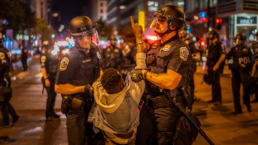A compilation of six decades of protest portraits show why we need abolition to end police violence on civilians. It’s not just notable victims like Breonna Taylor.
By Anna Blake, Scalawag
It’s hard to believe only—and somehow, already—two years have passed since Jonathan Mattingly, Brett Hankison, and Myles Cosgrove forced themselves, in plainclothes with a no-knock warrant, into the apartment on Elliot Ave in Louisville where they shot and killed 26-year-old Breonna Taylor.
News of her murder spread exponentially, eventually coming to a fever pitch following the murder of George Floyd two months later, some 700 miles away in Minneapolis. Suddenly, our city, once only known for horses, bourbon, and disco balls, became a hotbed of protests as activists and communities across the city gathered calling for justice for Breonna Taylor.

None of us bore witness to the negligent and violent events that took place in those early morning hours of March 13, 2020, but we don’t have to: Photographs taken in Louisville during the protests of 2020 reveal to us the fascist nature of the police state we live in.
Filmmaker and activist Susan Sontag, in her 1977 collection of essays On Photography, claims that “to take a picture is to have an interest in things as they are, in the status quo remaining unchanged.”
Recent Posts
‘Unconstitutional. Unethical. Authoritarian.’ ICE Bars Millions Of Immigrants From Bond Hearings
July 18, 2025
Take Action Now One watchdog said the new policy “seems like a blatant attempt to stop them from exercising their right to due process.”……
Americans Are Not Nearly Alarmed Enough About Climate Change
July 18, 2025
Take Action Now Americans still don’t comprehend how imminent, dangerous, and far-reaching the threat is—and journalists are partly to blame.By…
The IRS Is Building A Vast System To Share Millions Of Taxpayers’ Data With ICE
July 17, 2025
Take Action Now ProPublica has obtained the blueprint for the Trump administration’s unprecedented plan to turn over IRS records to Homeland Security…
Israel’s Sudden Assault On Syria Is Unchecked Aggression
July 17, 2025
Take Action Now Jerusalem is bombing Damascus and threatening al-Sharaa’s rule, while Washington was hoping to help the nascent government on…




